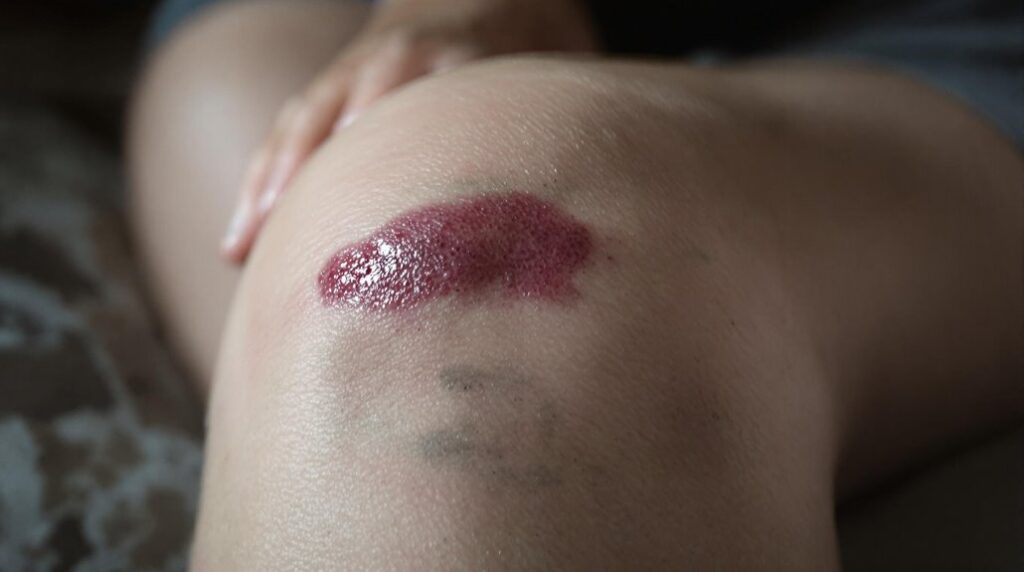Discomfort below the kneecap, often linked to Patellofemoral Pain Syndrome (PFPS), can result from overuse, improper mechanics, and muscle imbalances. Symptoms typically include dull pain during activities like squatting or running, and may worsen after prolonged sitting. It's important to take into account footwear, as supportive shoes can greatly influence your knee health. Engaging in specific exercises and utilizing the POLICE strategy for management can help alleviate symptoms. Learn more about effective strategies and when to seek professional help.
Understanding Patellofemoral Pain Syndrome
When you experience discomfort around your kneecap, it may be indicative of Patellofemoral Pain Syndrome (PFPS), a condition that affects a significant portion of both adults and adolescents. This syndrome is often linked to overuse, sudden changes in physical activity, and muscle imbalances. You might notice that activities like squatting, running, or climbing stairs aggravate the pain. Women are particularly at risk, being twice as likely to develop PFPS compared to men. The symptoms can vary, usually manifesting as dull, aching pain or discomfort after prolonged sitting. Management typically involves exercise modifications and targeted strengthening routines, with significant improvement often requiring up to 12 weeks. If symptoms persist beyond this timeframe, a referral to a physiotherapist is highly recommended.
Symptoms of Discomfort Below the Knee Cap
What are the key symptoms that indicate discomfort below the kneecap? You might experience a dull, aching pain, particularly during activities like squatting, running, or climbing stairs. This discomfort can worsen after sitting for extended periods with your knees bent, often referred to as the "theater sign." You may also notice clicking or grinding noises in your knee while moving, which suggests potential issues with patellar tracking. The intensity of your pain can vary, affecting one or both knees, and typically correlates with your activity levels. Given that patellofemoral pain syndrome (PFPS) is common among athletes, it is crucial to recognize these symptoms early to address them effectively.
Common Causes of Knee Discomfort
Discomfort below the kneecap can stem from several common causes, often linked to repetitive strain or improper mechanics during physical activities. One prevalent issue is Patellofemoral Pain Syndrome (PFPS), affecting about 25% of adults and 33% of adolescents. Overuse injuries from activities like running, squatting, and stair climbing contribute considerably to this condition. Sudden increases in activity intensity or frequency can also lead to discomfort. Additionally, muscle weakness or tightness around your hips and knees may exacerbate these issues, especially if you've been sitting for extended periods, which can create "moviegoer's knee." Other risk factors include being overweight and participating in high-impact sports without adequate conditioning, both of which increase stress on the knee joint.
Importance of Proper Footwear
Choosing the right footwear is essential for anyone looking to manage or prevent Patellofemoral Pain Syndrome (PFPS), as supportive shoes can greatly impact knee health. Proper footwear provides adequate support and alignment to the foot and ankle, reducing stress on the knee joint. Supportive shoes, particularly those designed for training, help distribute weight evenly, preventing excessive strain on the patellofemoral joint during physical activities. It's vital to avoid high-heeled shoes, which can exacerbate PFPS symptoms by altering knee alignment and increasing pressure on the kneecap. Well-fitting footwear that supports the arch of the foot can also prevent muscle weakness and subsequent pain. Additionally, custom-made or off-the-shelf orthotics may enhance foot and knee stability, further alleviating symptoms.
Effective Management Strategies
While managing discomfort below the kneecap can be challenging, implementing effective strategies can greatly enhance your recovery and overall knee health. Engaging in specific strengthening and stretching exercises tailored for your knee and hip muscles is essential. Gradually changing your activity levels, alongside pacing techniques, helps prevent muscle weakening and exacerbation of pain, with improvements often taking up to 12 weeks. Wearing supportive footwear that provides proper arch support can considerably alleviate pressure on your knee. Additionally, using the POLICE strategy—Protection, Ideal Loading, Ice, Compression, and Elevation—can effectively manage acute symptoms. Regularly taking analgesics like paracetamol or NSAIDs, combined with weight management techniques, also aids in controlling pain and facilitating a return to normal activities.
When to Seek Professional Help
Knowing when to seek professional help for knee discomfort is essential to prevent further complications. If you experience persistent discomfort below the kneecap lasting more than a few weeks, it's important to consult a healthcare provider, especially if the pain worsens with activity. Accompanying symptoms like swelling, redness, or warmth signal potential inflammation or injury, necessitating medical evaluation. If knee discomfort interferes with daily activities, such as climbing stairs or kneeling, this limitation could indicate a significant issue. Additionally, popping or crackling noises in conjunction with pain may suggest problems with patellar tracking or cartilage. Finally, if self-management strategies like rest and ice haven't improved symptoms after 6 to 12 weeks, seeking professional advice is advisable for proper diagnosis and treatment.

